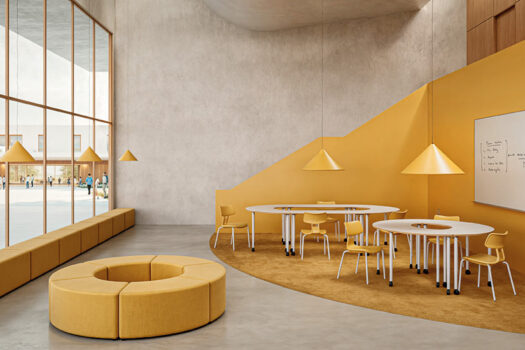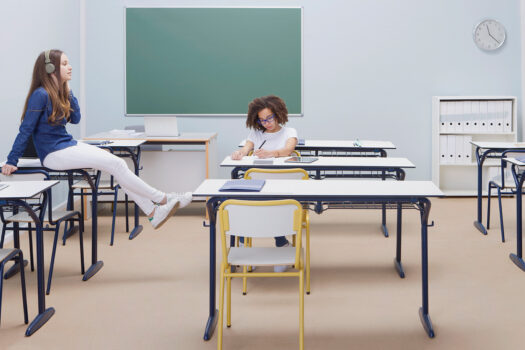Director of the Diocesano School, José Ramón Navarro Pareja, collaborates with schools that aim to transform education by focusing on three key areas: the implementation of a methodology that makes students the protagonists of their own learning; the introduction of technology in the “one to one” model, where it serves as a tool, not as the final objective; and the modification of educational spaces to make them more versatile, open, and comfortable.
In your work, you have used furniture to reorganize not only learning spaces but also students’ leisure areas. Is this something schools are investing in to encourage learning?
Navarro Pareja: Of course. And not only the distribution of furniture, but also the incorporation of furniture that was not originally designed for the classroom, such as sofas, armchairs, poufs, cushions, boxes, and even clotheslines. Additionally, this is applied throughout the entire school, in hallways, common areas, patios, bathrooms… So, when we start changing the methodology of work in the classroom, we make students more autonomous and, furthermore, respect their different ways of learning. In this situation, we realize that the traditional classroom no longer serves its purpose.
The classic arrangement of classrooms, with individual desks facing the teacher and the blackboard, does not teach the student to work in groups, to share, to send a message, to be critical, or even to be creative. To achieve this, we need an environment where students feel comfortable, where they want to work, where they can share with their peers and collaborate with others. A space, in short, where they want to stay!
To achieve this, we need to create a classroom and school that facilitates reflection, meeting, and group work, intensive study, project presentation, and creative work.
Being more autonomous, developing creativity, and working in groups are goals that are increasingly embedded in education. However, many concerned parents focus first on academic performance. How can furniture, decoration, or the arrangement of the classroom improve this?
Navarro Pareja: Talking about improving performance seems a bit premature and superficial to me. The truth is that there are no studies proving that different spaces or setups increase grades. I don’t think it’s a factor that alone determines success. However, in spaces where students feel comfortable and work well, their performance is better. I have personally observed that students act differently depending on the spaces they are in. In a traditional classroom, when the bell rings for recess, the evacuation time is record-breaking. In classrooms like the ones described, there are children who ask permission to stay, to work, chat quietly with their classmates, or simply rest.
In this sense, what could the perfect classroom look like?
Navarro Pareja: Spacious, bright, warm, comfortable, and with different areas. These needs are very similar across all ages, so the main difference is likely the size of the furniture and classroom decoration. Other than that, it shouldn’t differ much from a teacher’s lounge.
One of the lines that is increasingly being applied in schools is the improvement of the relationship between teachers and students. Until now, the common model was the lecture-based classroom, with the teacher facing the students. Can the arrangement of furniture influence this relationship?
Navarro Pareja: Absolutely. In a classroom with desks separated in rows, all facing the blackboard, and with the teacher elevated on a platform, the only possible relationship is one-directional, from the teacher to the students. When we arrange students in groups and remove the teacher’s desk, we force the teacher to change their methodology. You can’t spend an hour talking to students who might be facing the other way. On the contrary, the teacher has to move around the class, approach students, stop by those who need help, and meet them at their level.
These are not the only factors influencing better learning. Technology has been implemented in classrooms and seems to be here to stay and expand. Do you think technology could be incompatible with a new way of teaching?
Navarro Pareja: Is technology incompatible with any aspect of our life? We use it to shop, to stay safe and connected, to improve our quality of life, to heal or become healthier. So why would anyone want to reject it in school? It’s not incompatible; it’s necessary because it’s part of our lives, and therefore it should also be in the place where we prepare new generations for life.
What is questionable is how it is used. This often happens in family settings. How many parents give their children a mobile phone to keep them quiet in a restaurant or during a conversation with friends, and then complain that their children are addicted to the internet and games? In fact, well-implemented technology in schools serves the opposite purpose, to use it in ways that make our lives easier and more comfortable.
Should we encourage learning through play, fun, and emotions? Or is it better to continue with traditional techniques?
Navarro Pareja: We need to learn from what truly motivates students. For example, we tell a teenager that we are going to assign them a project that will require more than a hundred hours of work. A project that they don’t know how to do and for which no one has taught them, and they will have to learn along the way. A project in which they will make many mistakes and, when this happens, they will have to start over. A project that no one will supervise, and that they will only complete if they put all their effort into it. And when they finish, the only reward will be the satisfaction of having achieved it. What would they say? Most likely, they would walk away because they would rather play on the console than deal with something so demanding.
But think about it. What I just described is actually a video game! It has all those challenges, yet students are able to spend hours on it without anyone asking. Video game manufacturers have succeeded in engaging and motivating students in something so difficult and time-consuming. Why not use those same mechanisms in the classroom? And I’m not talking about playing or replacing the blackboard with a console, but about discovering what really motivates them to engage them in learning in that way.
Another successful element is the emotional one. Recent neuroscience research clearly shows how connected emotions are to learning. Try to remember the teacher who had the biggest impact on you in Primary School. Was it because of their eloquence or wisdom? Probably not, I’m almost sure it was because of their empathy, their ability to connect with you. Many people have been so influenced by this positive impact that it helped them choose their profession, lifestyle, or dreams…
With so many changes, some may question the validity of traditional teaching techniques. Do they really work?
Navarro Pareja: They work, of course, depending on what you’re trying to achieve. With traditional teaching, we manage to get some students — because many others disengage — to learn a large amount of content that helps them pass exams. It’s like driving school. We learn the traffic rules and practice over and over until we pass the exam. But do we know how to drive when we get our license? I think we can all agree that we don’t. Real learning begins afterward, when we get behind the wheel, and ironically, we start forgetting many things we memorized, but we keep the meaningful knowledge, the things we really need.
Do we want to turn school into a fifteen-year-long driving school course? That’s why we need to guide students more towards understanding than memorization, so they can grasp the “why” behind learning and apply it in different situations. We need to train students who are autonomous, capable of constructing their own learning, as they won’t even know what professions they will have. In fact, they most likely don’t even exist yet.



